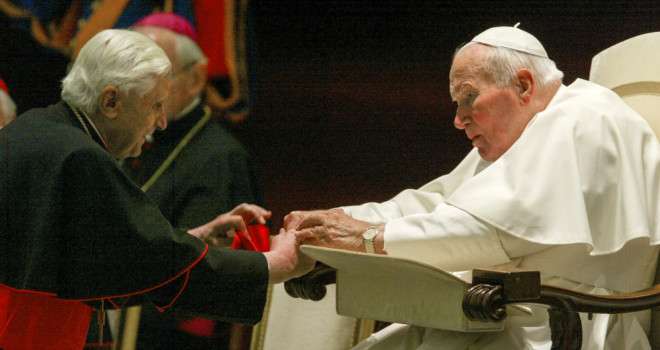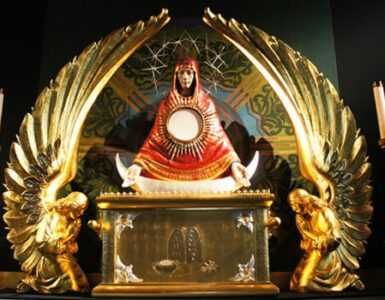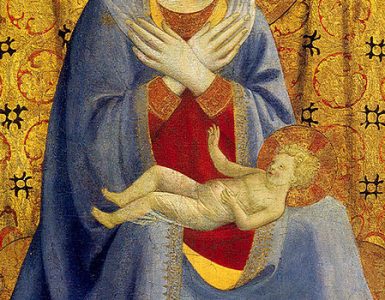Having recently encountered somewhat of a Lenten Eucharistic pilgrimage by taking a closer look at the some of the papal documents from the Philosopher, Pope St. John Paul II, and the Professor, Pope Benedict XVI, some important similarities between their respective thinking about the Holy Eucharist came to light. To distill their collective insight and their genius could be a dissertation topic in and of itself.
The richness and scope of their observations, as well as their reflections in these texts, are a shared treasure of a deeper meditation on the importance of the Eucharist in our lives. Their wisdom gives us an opportunity to take a moment during our Lenten journeys and ponder the awesome wonder of what and Whom we encounter in the Sacrament of the Most Holy Body and Blood of Christ.
There are, indeed, a number of key concepts that run through each of the three documents Dominicae Cenae (“DC,” JP II, Feb. 24, 1980), Ecclesia Eucharistia (“EE,” JP II, Apr. 17, 2003) and Sacramentum Caritatis “(SC,” B16 Feb 27, 2007). In short, these revolve around the Christocentric nature of the Eucharist’s inextricable connection with the Church in the elements of Sacrifice, Sacrament, Gift, Mystery, the Beauty of the Liturgy and in the person of the Blessed Virgin Mary as a model of Eucharistic love.
Sacrifice
Pope John Paul II (JP II) notes how the sacred character of the Eucharist is, by nature and above all, a sacrifice (DC). He says the Mystery of Faith explains the sacrificial nature of the Eucharist as the one sacrifice of the cross (EE). Pope Benedict XVI (B 16) begins his first chapter by stating Christ laid down his life as a sacrifice for his friends in this Sacrament of Charity (SC).
Sacrament
Pope John Paul II emphasizes the sacramentality of the Eucharist as one of two “tables of the Lord” in the form of “the Table of the Bread of the Lord” at the Mass (DC). He refers to the Eucharist as the “source and summit of our faith” which is “veiled” (sacramentally) in the Eucharistic species (EE). Pope Benedict XVI says our faith is nourished by the Blessed Sacrament and devotion to the Eucharist strengthens our commitment to the Church” (SC).
Gift
Pope John Paul II indicates the Eucharist is the “life-giving current” linking the ministerial priesthood to the common priesthood. (DC). He says neither the priest nor the faithful “possess” the Eucharist but receive the Eucharist as a gift on behalf of the entire Christian community (EE). Pope Benedict XVI mentions the Eucharist is “Jesus’s transformative self-gift” (SC).
Mystery
Pope John Paul II explains how the Eucharistic Mystery is the very life of the Church. Worship of the Eucharistic Mystery through the worship of the Holy Trinity permeates the celebration of the liturgy (DC). He reiterates a deeper reflection of the Eucharist as the source and summit of the Christian life contains the entire Church’s spiritual wealth. And the Paschal Mystery is and should be contemporaneous with men and women of every age (EE). Pope Benedict XVI says the Eucharist is the “Mystery of Faith” par excellence, the mystery of Trinitarian love and the Mystery of Jesus’s transformative self-gift, also the mystery at the heart of the Church’s origins and celibate priesthood, and a mystery of the eschatological age, (SC).
Liturgy
Pope John Paul II says the Eucharist belongs to the whole Church, the sacrament of her unity. The Church, therefore, acts and expresses herself in and through the liturgy (DC). The Church is the minister of Christ’s body and blood for the salvation of the world, and Mass should be marked by outward signs of joy emphasizing the incomparable gift of the Eucharist. The art, architecture, music and sculpture in Churches need to reflect a beauty associated with the liturgy (EE). Pope Benedict XVI says the Eucharist is a mystery to be celebrated in the beauty of the liturgy. Adoration and Eucharistic devotion are important and Eucharistic spirituality must embrace our entire lives (SC).
Blessed Mary
Pope John Paul II ends DC with asking the intercession of the Blessed Mother, holy spouse of the Holy Spirit and Mother of the Church, to receive the light of the Holy Spirit (DC). St. John Paul’s seventh chapter is titled “At the School of Mary, Woman of the Eucharist” and points to her as the first Eucharistic “tabernacle” and model of Eucharistic piety (EE). Pope Benedict highlights Mary’s Assumption is a sign of true eschatological hope of which the Eucharist enables us to have a foretaste (SC).
We will never fully realize or understand the awesome presence and magnanimity of the Holy Eucharist in time. Our intellect is limited in the face of experiencing the limitless and the eternal. But to dwell, even momentarily, on some of the more salient and meaningful aspects of what we can grasp and process in the here and now when it comes to the Eucharist offers us a more significant experience in receiving the Lord in the sacrament he instituted at the Last Supper.
✠












